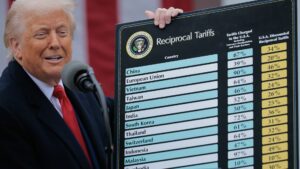Understanding Trump’s Tariff Strategy: Implications for Global Markets and Your Investments
As financial pundits worldwide grapple with the recent tariff announcements from the Trump administration, many are left questioning the primary motivations and implications of these economic maneuvers. The recent “Make America Wealthy Again” trade announcement has sent shivers down the spines of global markets, indicating that U.S. trade policy is once again under scrutiny.
Unraveling the Tariff Figures
In an intriguing turn of events, President Trump and his administration made waves by showcasing a series of charts on social media. These charts are meant to depict the purported tariff rates imposed on U.S. imports by various countries. Yet, the figures presented raise eyebrows and provoke skepticism. For instance, many of these claimed rates appear to be roughly half of those in more established data sources.
At the Extreme Investor Network, we delve into the details. A recent analysis discovered that the formula used by the Trump administration to calculate these tariffs appears to hinge on the U.S. trade deficit with individual nations, rather than traditional tariff measures. This unconventional approach suggests that the administration’s calculations are guided more by the need to offset trade imbalances than by a reciprocal standard.
The Math Behind the Madness
To illustrate, the claimed Chinese tariff stands at an astonishing 67%. When the U.S.’s trade deficit—$295.4 billion with China in 2024—is divided by total imports from the nation—valued at $438.9 billion— the result is an ominous 67%, which conveniently matches the administration’s assertions.
However, such methods yield complex ramifications, particularly for smaller trading partners in Asia and beyond. By focusing solely on the trade deficit without factoring in service sectors, numerous nations may find it difficult to comply with U.S. demands to balance these tariffs, as highlighted by Trinh Nguyen, a senior economist with Natixis.
The Long-Term Effects on Trade Dynamics
While higher tariffs are often touted as a pathway to a more robust domestic economy, the reality is multifaceted. Countries like Vietnam, which boast a substantial surplus in trade with the U.S., may witness their economies stifled further if they are pressured to conform to these new tariff models. It’s noteworthy that Vietnam has already made efforts to reduce tariffs voluntarily, signaling its commitment to beneficial trade relations.
Here at the Extreme Investor Network, we believe understanding these nuances can inform smarter investment decisions. The potential for higher consumer prices resulting from imports getting costlier may affect demand, putting additional strains on consumers’ purchasing power.
The U.S. Trade Representative’s Stance
In an official statement, the Office of the U.S. Trade Representative (USTR) elaborates on its complex methodology. By striving to reduce bilateral trade deficits to zero, the USTR contends that such measures will foster “fair trade.” Yet, analysts suggest that this opacity in tariff figures might provide the government with negotiating leverage in trade discussions, albeit at the risk of diminishing U.S. credibility on the world stage—a concern expressed by Rob Subbaraman of Nomura.
What It Means for Investors
As the global economy teeters on the edge of uncertainty, investors must remain vigilant. The implications of these tariffs can ripple throughout supply chains, affecting the cost and demand for imported goods, potentially leading to inflationary pressures. The market has already responded to these tariffs, illustrating the delicate interconnectedness of global trade relationships.
At Extreme Investor Network, we continuously analyze these developments to provide our community with actionable insights. Knowing how shifts in trade policy could affect various sectors can empower investors to make informed decisions that protect their portfolios.
Conclusion
The unfolding scenario around U.S. tariffs serves as a stark reminder of the volatile nature of global economics. As always, understanding the underlying metrics and broader implications can separate successful investors from those who falter in times of change. Stay tuned with Extreme Investor Network as we bring you the latest insights and expert analyses to navigate this unpredictable economic landscape effectively.

